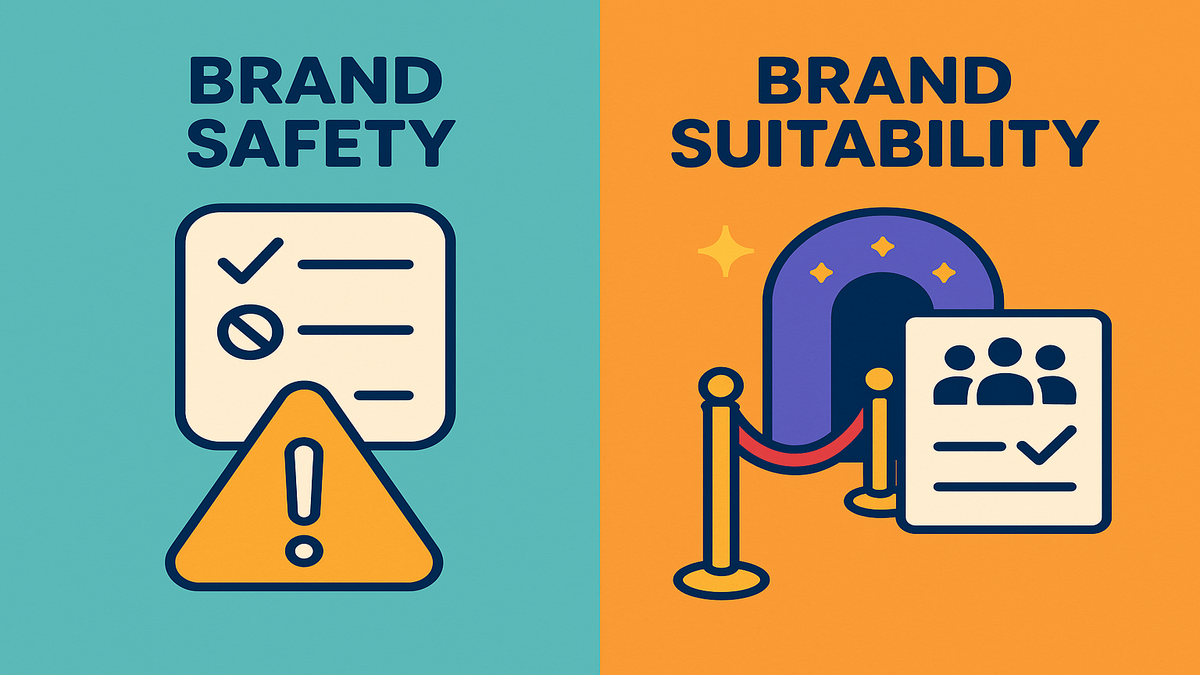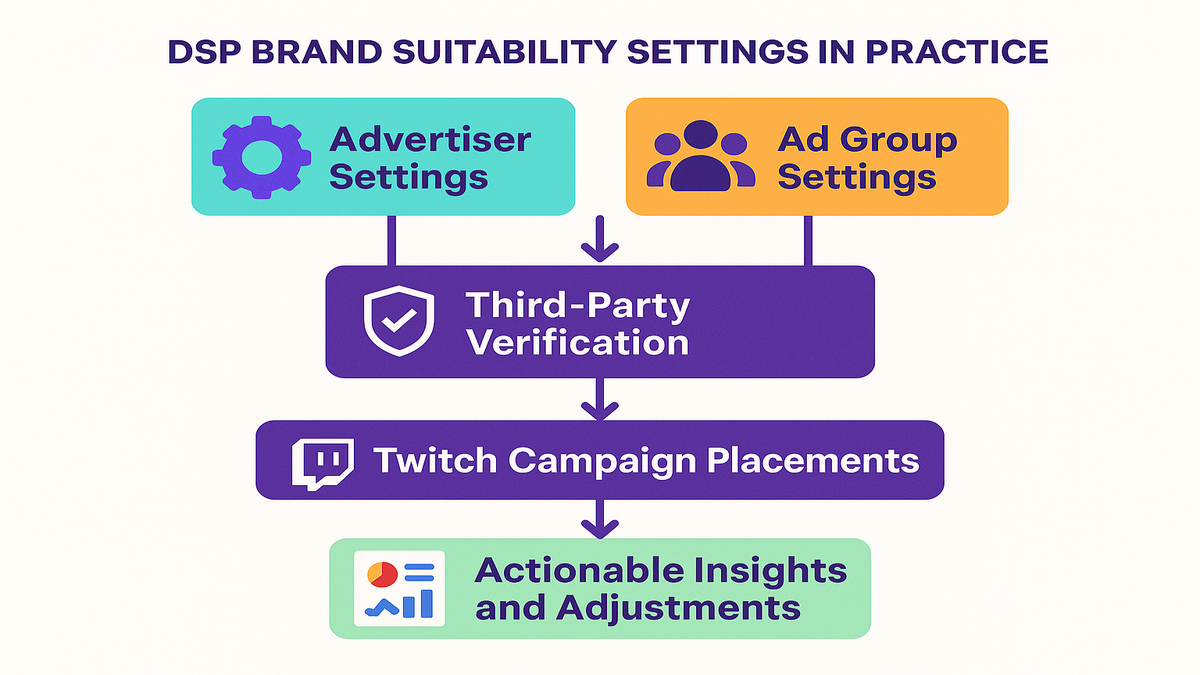
Master DSP Brand Safety With These Suitability Settings

Ever see your ad stuck next to a total online mess? Like, one second you’re happily pushing healthy pet snacks. Then, boom—right between a random scary YouTube short and some guy yelling about the moon landing. Not the boost you wanted for your brand, huh?
It’s not just a whoops moment. It’s real. Every spot counts now, especially with stuff like Twitch and streaming ads. Bad placement? Your brand could be trending for the wrong reasons faster than you can say, “Not my fault!” Trust goes down. Fast. That’s why the smart money worries where an ad shows up, not just what it says.
Amazon DSP’s latest move? New brand safety and suitability settings. But these aren’t just boring switches. Think of them like airbags for your reputation—and now you can try them in open beta. They let you pick and choose, stay in control, and stress less as your Amazon Ads work harder. DSP Services can help run your campaigns without risking your name.
TL;DR
- Brand suitability = your ad fits in—more than just avoiding crazy stuff.
- Open beta gives deeper controls for Twitch display & video campaigns.
- Use tools like DoubleVerify to filter out extra risks.
- Read the reports! See where your brand went, block the weird stuff.
- Beta will change—keep making tweaks as new options show up.

Say Goodbye to One-Size-Fits-All Brand Safety
Brand Suitability Defined
Think of basic brand safety like dodging the internet’s sketchy late-night alleys. Suitability? That’s picking what kind of party your ad even walks into. If you sell fizzy drinks, of course you’ll skip violence or adult mess—but maybe also boring news, too much drama, or health scares. It’s not just about danger. It’s about picking spots your crowd actually wants to hang out.
Each brand has its vibe. A toy company? No way they want to show up on shooting games. A snack brand? They’ll probably avoid super sad or heavy videos. Suitability helps you fine-tune this, so ads always match your style.
Safety vs. Suitability
- Safety: Avoid the toxic stuff. Nothing illegal, nasty, dangerous, or wild. Like, don’t run ads on hate speech.
- Suitability: Now you get picky. What really fits your brand? A fancy perfume won’t want ads on kids’ slime videos—even if those are "safe."
Ana Jimenez, who’s deep in digital media, said it nice:
“Suitability filters are the velvet rope—safety’s just the bouncer.”
In 2024, big brands aren’t just avoiding blow-ups. They’re steering the talk they’re part of.
Under the Hood
Tweak Controls
Open beta is for folks who love to tinker. Amazon DSP now lets you build controls both across your whole brand and for just one ad group.
Veggie chips and don’t want to show up next to meat? Block it for everyone. Run a wild summer push? Maybe block risky stuff for just that campaign. Here’s the setup:
brandSafetyTierInheritedSettingDetails: Set rules for your brand across the board.brandSafetyTierTarget: Use more detailed settings for single ad groups.
This is not swinging a huge axe. It’s being a surgeon.
Third-Party Tools
Drop in the experts: DoubleVerify, IAS, Peer39. Their segments make your controls smart and fast.
- Add segment IDs for stuff like “bad language” or “fake news.”
- Decide: brand, ad group, or just one campaign?
- Layer segments however you want. Make your filter tight or loose.
Think of these like bodyguards checking rooms before your ad walks in.
Helpful Reports
No more set and forget. New Amazon DSP reports give you:
- Lists of publishers (who posted your ad—like Twitch streamers or YouTube folks).
- Content type breakdowns. Was your ad on “Funny Clips” or “True Crime”?
- When and where your brand showed up with others.
You won’t be stuck asking, “Wait, where did my ad go?” anymore.
Fine-Tune or Get Burned
Real-Life Examples
Let’s make it real. A pet brand might love calm music but never, ever wants ads on hunting shows or horror flicks. They want to look wholesome. Or a fashion brand for teenagers—no boring news, nothing political, and skip songs with cussing. It’s about vibes, not just basic safety.
One Amazon DSP client said:
“After separating safety and suitability controls, our cost per view dropped by 15%. People linked us with better content and liked us more.”
That’s a win—for money and trust.
Easy Setup and Fixes
You can set rules before you start the ad campaign: budget, when it runs, device types, and what content to exclude. But if new stuff pops up, you can change rules right away. If you’re running back-to-school ads, get stricter for that group. Catch a weird trend? Patch it fast—no need to start over.
Pre-bid vs. Post-bid
Here’s a little tech: Pre-bid filtering checks stuff before you even buy the ad spot. That saves mistakes early. Sometimes a weird thing still slips through. Post-bid filtering can block it even after your ad is shown (sometimes the bill gets fixed too). AI checks everything so your sunny shampoo ad isn’t next to a Halloween chainsaw video.
This is how you don’t just avoid disasters—you pick the best spots for your brand.

Meet the Big Dogs
Third-Party Collaborations
DoubleVerify, IAS, Comscore, and Peer39 go deep with Amazon DSP:
- Pre-built blocks: Button-press to block scammy, risky, or just plain weird stuff.
- Custom fit: Build your own segments for your perfect mood—think “chill, but never boring.”
- AI upgrades: They keep getting smarter, auto-updating for new scams or internet weirdness.
A senior programmatic boss told AdExchanger:
“Without third-party verifiers, DSPs can miss the weird edge cases. Our blocks keep out over 95% of the mess.”
If you spend big on ads, this is how you keep your peace of mind.
Beta Quirks
Heads up: Some high-level blocks (like deep fraud guard) might cost extra. Read the fine print before you get clicky. Since this is a beta, sometimes bad placements get through—especially since Twitch is still rolling out all the coverage. Stay sharp. These controls are great, but not magic.
Panic Button: Reporting & Tweaks
Always Stay Curious
Suitability reports now track your campaigns live. Amazon DSP shows which publishers host your ads. If you don’t like one, block ‘em and move on—saves headaches later.
Keep Checking
- Read your reports every time you run a campaign.
- Find new weird spots—like a streamer who blows up for drama or weird search words? Block them right away.
- Don’t block everything! If you cut off too much, ads cost more and you lose reach. Be careful, not scared.
Tuning your settings every campaign helps you dodge new trouble without falling behind.
Beta Changes
Open beta means things are still shifting. Some features may change or show up, and not all Twitch inventory is covered yet. This is your sandbox. Amazon’s team said it straight:
“Advertiser feedback now will shape the product for years. Use these controls, break things, tell us what works.”
See something broken? Report it, and help improve the tools for everyone.
Suitability Settings Do’s and Don’ts
- Brand first—always. Your ad should feel like it belongs.
- Use outside tools for extra filters.
- Set segment IDs for detail control.
- Treat reports like your stat tracker.
- Tweak settings when beta adds new stuff—don’t blink or you’ll miss something cool.
Quick Recap
- Ad-group and advertiser controls = super tight placement.
- Third-party layers let you pick exactly what to block.
- Reporting keeps you in-the-know—fix problems as they come.
- AI means smarter campaigns. Keep your moves quick!
Mini-Recap
- Suitability isn’t just “don’t be mean.” It’s “show up where people actually like you.”
- Beta = more tools, but you gotta stay on it.
- Don’t go solo—use third-party verifiers.
- Watch, block, tweak, repeat—always protect your brand.
- Twitch is just the start. Amazon DSP will keep adding new ad spots. You gotta stay ready.
FAQs
1. What’s the difference between "brand safety" and "brand suitability"?
Brand safety is about avoiding the real bad stuff. Suitability means being picky, so your ad fits your style—even if content is “safe.”
2. How do these controls work at ad group vs. advertiser?
Advertiser-level is wide rules for the whole brand. Ad group lets you change or override them for smaller campaigns.
3. Why trust DoubleVerify or IAS?
These teams focus only on blocking fraud, hate, and weird topics. They update fast, so you don’t get blindsided. Your in-house settings are good, but these guys make them tighter.
4. Can over-blocking hurt your campaign?
Yeah. If you block too much, ads cost more and your reach shrinks. Get focused—don’t go wild.
5. What does suitability reporting show in Amazon DSP beta?
Reports show where every ad lands. You see the publisher, content type, and context. Every campaign, use this to block or adjust stuff.
6. What’s limited in open beta?
Coverage is still small—mostly Twitch. Some ad types or devices might not be ready yet. Advanced filters might cost extra. Watch your invoices and settings!
Crush Your Suitability Strategy
- Figure out your brand’s style. What’s a fit? What’s a flop?
- Set broad rules. Use 'brandSafetyTierInheritedSettingDetails' for basics.
- Fine-tune per ad group. Use 'brandSafetyTierTarget' to lock in what each campaign needs.
- Plug in DoubleVerify or IAS. Grab their segment IDs for extra blocks.
- Read your reports, nonstop. Every cycle, check: where did you show up? What rocked? What bombed?
- Keep testing. Start small, nudge things, find the sweet spot. Only scale after you see proof—it saves you pain later.
A decade ago, staying “safe” meant avoiding sketchy blogs. Now, you have to be on guard and pick the best fits. Amazon DSP’s new settings are your tool kit to play with the big dogs.
Next step? Block the junk, boost the gold, and let your brand do the talking—no matter what gets thrown your way.
Ready to go next-level on Amazon Ads? Want more features to power up your campaigns? Check out Features and break out of the basics.
Need a cheat sheet? Try Amazon’s DSP optimization guide, explore the Attribution toolkit, or see the magic with an Amazon Brand Lift Study. Defend your brand. Grow your reach. Stay ahead of the internet.

